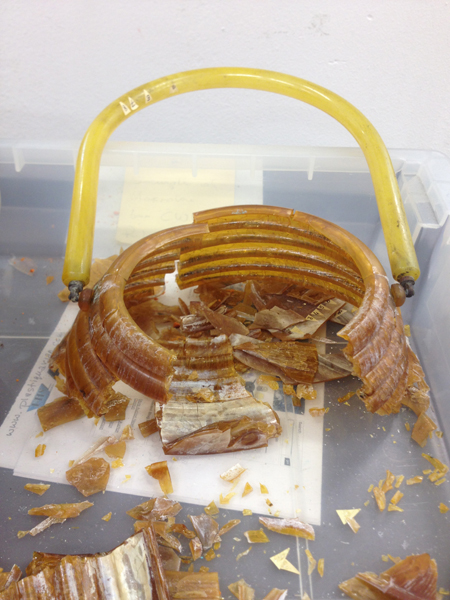So then, Plastics… Why do we need to conserve things that we have been told last for hundreds of years in rubbish dumps?
Well it turns out that some plastics don’t last that long at all! In fact rather than thousands of years we can be talking about very short lengths of time.
The key thing to note from the guardian article is this line – “These are plastics made to degrade in the presence of oxygen and sunlight, thanks to the addition of tiny amounts of metals like cobalt, iron or manganese.” In other words, engineered impurities that lower the lifespan of the object, with oxygen and sunlight (read: UV light) doing the real damage.
Plastic objects that we find in museums mostly likely will not have these impurities engineered into them, but through poor manufacturing techniques – typical of the early plastics, will have them naturally. (See sections 2.6 & 2.7 here)
The degradation of plastics can take many forms, but most lead to some pretty dramatic end results! Take this object for starter;
When I arrived (in a more nervous from that normal) to my interview here I was given a tour of the lab – that was February, and back then it still had its clear lid attached and its form was such that one knew it was a handbag. Now it’s mostly dust…
The most worrying aspect of this type of decay is its effect on its surroundings. We see below that when plastics degrade they can also cause the corrosion of metals in the surrounding area. This is a very important behavior that must be taken into account when we store plastics.
Over the course of the next year or so I will mention a couple of ‘technical’ terms…I say technical because in the context of plastics conservation they have exact meanings – yellowing is pretty obvious, but in this context it implies a method of decay and also its results.
One of the more impressive forms of decay is “crazing” :
This happens when the plasticizer used during manufacture evaporates away, water molecules take its place, hydrolysis starts and as a result the plastic just turns to dust.
We may not realize it but plastics can be found in object that we may never have thought would contain them. Quite a lot of furniture can contain plastic foam as the cushion. The major problem with this is when it starts to decay and break apart. In the image below we see the imprint of my thumb, if I were to push further or move the foam in another way it would simply crumble away – now consider that many pieces of 20th century furniture contain this material…
One of the more disgusting methods of decay is called sweating;
This when the plasticizer or other additives migrate to the surface of the object; they can form beads of liquid on the surface which in turn trap dirt, dust and particulates on the surface of the object. These are extremely difficult to remove from the surface.
Along with these specific types of damage we also find that plastics are just as vulnerable to regular damage as anything else. We get the normal cracks and chips that we find in objects made of other materials:
Lastly, the problem we most face with plastics is simply a build-up of dust and dirt.
This is an area that causes many issues within the field as little has been done to study the effects of different cleaning techniques and materials. POPART made a very good start at investigating what could and more importantly could not be done. A major part of my internship will be repeating some of the POPART experiments and as such you will see a lot of the results here.
PS: The objects you see on the blog are mostly taken from our ‘teaching’ collection here in the lab. One nice thing about plastics is that as they were so widespread that we can pick up old objects in car boot sales and the like, and sacrifice them in the name of research!




Hi Mark, a fascinating blog from which am sure am going to learn loads! Is it possible to subscribe in order to receive new posts as you post them? Fiona
Hi Fiona,
There should be a ‘Follow’ link on the top left corner of the black bar that runs across the top of the page (…that is if you have a word press a/c). If you dont have a wordpress a/c then i think on the bottom right of the page there should be a gray box with ‘+follow’ in it and you can put your email in there to subscribe.